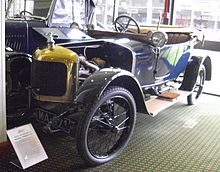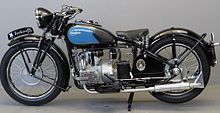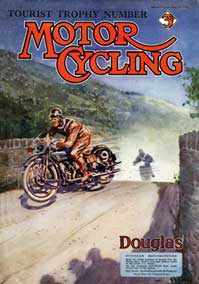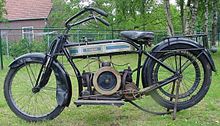Douglas Motors
| Douglas Engineering Company 1882–1907 Douglas Motors 1907–1931 Douglas Motors, Ltd. 1931-1935 Aero Engines Ltd 1935-1946 Douglas (Kingswood) Ltd 1946-1957
|
|
|---|---|
| legal form | |
| founding | 1882 |
| resolution | 1956 |
| Reason for dissolution | Reorganization after takeover |
| Seat | Bristol , UK |
| management | William Douglas, Edwin Douglas |
| Number of employees | 3000 (around 1918) |
| Branch | Mechanical engineering , iron foundry , motorcycles , aircraft engines , automobiles |
The Douglas Motors Ltd. and their predecessors were British manufacturers of motorcycles and, for a short time, small cars . The company was based in Bristol . The company was founded in 1882 by the brothers William (around 1859–1937) and Edwin Douglas (1865–1905) as a mechanical workshop with a forge and a small foundry and existed until 1931. Motorcycle production began in 1907 after the engine manufacturer Light Motors was acquired . After the sale and reorganization as Douglas Motors in 1931, William Douglas bought the company back in 1934, but had to close it the following year. The systems were built by the defense and industrial group Aero Engine, Ltd., also founded in 1935 . taken over, initially with no intention of continuing to manufacture motorcycles. Their production was resumed in 1936 and continued until 1956.
origin
The family originally came from Greenock in Scotland and belonged to the Douglas-Hamilton clan . William and Edwin's parents were John Douglas (1833–1874) and Mary Wilson Douglas (* 1835; † unknown). The father was an engineer. William was born in Newcastle-upon-Tyne around 1859 . Apparently shortly afterwards the move to Bristol, where John Douglas opened a mechanical workshop with machine construction around 1860. In 1871 the company employed three employees and three assistants.
Douglas Engineering Company
William Douglas began repairing machinery for the shoe industry in Kingswood , a suburb of Bristol . In 1880 he entered into a partnership with Edwin. They made products from cast brass and iron. The Douglas Engineering Company emerged from this in 1882 . A £ 10 GB loan was used to invest in a mobile forge , vice and grindstone . The brothers paid back the loan in just three months. They began to manufacture devices for the shoe industry and produced cast iron parts such as manhole covers and masts for street lighting . In 1897 larger facilities were moved to Hanham Lane in Kingswood. Here you came into contact with Light Motors Ltd. for which they cast engine components.
Douglas Motors

Douglas was particularly known for its air-cooled, transversely installed (i.e., with the cylinder axes in the direction of travel) boxer engines. Joseph Barter, the founder of Light Motors Ltd. , had designed such an engine called Fairy ("Fee"), but had to give up his business in 1907 and sold it to the Douglas brothers. These began to produce a 350 cc version.
From 1912 Douglas manufactured water and air-cooled V2 engines for motorcycles and small cars for the Williamson Motor Company in Coventry . In 1914, the Douglas 9 hp began manufacturing light automobiles, which was interrupted by the First World War. During the war, the government took over the work. Douglas received an army order for the delivery of 15,000 machines. The output was 300 motorcycles daily; the company had up to 3000 employees. Douglas built a total of around 25,000 motorcycles of various types for the armed forces.
The 1920s

After the war, the market was literally inundated with decommissioned, well-maintained and inexpensive motor vehicles. This also applied to motorcycles and was a problem for the industry. Douglas became purveyor to the court; two sons, King George V , Prince Albert Frederick (later King George VI ) and Henry, 1st Duke of Gloucester , rode Scott motorcycles.
In 1920 the W20 was introduced with a 348 cm³ two-cylinder engine, kick starter and three-speed gearbox. The machine was with speedometer, Lucasl - Acetylenbeleuchtung particularly well equipped, knee protection, a protective shield under the crankcase, holder and pocket for spare parts and even a watch on the handlebars. The brand made reference to the Scottish roots of the family with its logo and by attaching a decorative ribbon with a plaid check to the tank of some motorcycles. The caricature of a Scotsman also served as a distinguishing feature in advertising for decades.
Also in 1920, small car production with the improved Douglas 10.5 hp was resumed. It was unsuccessful and production ended in 1922 after a few hundred copies had been built.
The EW series was introduced in 1926 and expanded to five versions in the following year. In 1927 the plant was affected by a fire. Douglas machines were particularly suitable for speedway races, so special competition models with 500 and 600 cc were offered.
Aero Engines Ltd
In 1931 Douglas Motors was converted into a public company and sold. The following year, new models appeared, but the company ran into financial difficulties. The British Aircraft Company experimented from 1932 with an aircraft engine based on the Douglas 600 cm³ engine. The result was the BAC Planette light aircraft . BAC owner CH Lowe Wylde died in May 1933 while demonstrating such a machine . British Aircraft was sold to Robert Kronfeld the following year . This seems to have ended the experiments with Douglas aircraft engines. In 1934, William Douglas bought the financially troubled company back, but it was voluntarily wound up the following year.
The plants were taken over by the British Pacific Trust , which had founded a subsidiary with Aero Engines Ltd in order to, among other things, reproduce the aircraft engines from Hispano-Suiza under license and which required the former Douglas plant . Motorcycle production was stopped for a short time, but continued under the old brand name as early as 1936. Production was maintained during the Second World War and expanded to include components for fighter aircraft. Since more than half of the products sold were under the Douglas brand name , it was decided in 1946 to reorganize Aero Engines as Douglas (Kingswood) Ltd , but Douglas ran into difficulties again in 1948. Only variants with 350 cm³ and an engine lying transversely in the frame were produced. In 1949 the import of Vespa scooters began, which Douglas manufactured under license from 1951 . A prototype with 500 cm³ from the same year did not go into series production.
End of motorcycle production
1955 came with the 350 cm³ Douglas Dragonfly the last motorcycle on the market. Westinghouse Brake and Signal bought Douglas in 1956 and ceased motorcycle production in 1957. The import of Vespas continued. Gilera and light motorcycles were also imported for a long time by Westinghouse Brake and Signal under the Douglas brand name .
Westinghouse Brake and Signal Co. existed until 1981.
Racing
Douglas machines took part in racing events as early as 1910. In 1912 Harry Bashall won the first important prize for the brand with his victory in the junior class at the Tourist Trophy . In 1913 a Douglas won the French Grand Prix in the sidecar class up to 350 cm³.
The Tourist Trophy was successful three more times: The Senior TT was won in 1923 by Tom Sheard , who had been successful in the junior class for AJS the previous year . Also in 1923, Freddie Dixon and Walter Derry won the team class. Len Parker and Ken Hirstman repeated this success in 1925 .
Douglas held 150 national and international records in 1923.
Models
motorcycles
This compilation is still incomplete.
- 2¾ HP model A 340 cm³ - 1907- approx. 1908
- 2¾ HP model B 340 cm³ - approx. 1907– 1909
- 2¾ HP model D 340 cm³ - 1911
- 2¾ HP model E 340 cm³ - 1911
- 2¾ HP Ladie's Model F 340 cm³ - 1911
- 2¾ HP model G 340 cm³ - 1912
- 2¾ HP model H 340 cm³ - 1912
- 2¾ HP model J 340 cm³ - 1912
- 2¾ HP model K 340 cm³ - 1912
- 2¾ HP Ladie's Model L 340 cm³ - 1912
- 2¾ HP model N 348 cm³ - 1913
- 2¾ HP model O 348 cm³ - 1913
- 2¾ HP model P 348 cm³ - 1913
- 2¾ HP model R 348 cm³ - 1913
- 2¾ HP Ladie's Model S 348 cm³ - 1913
- Douglas 350 cm³ - 1910
- Douglas 349 cc - 1914-1918
- W20 348 cc - 1920
- CW12 - 1924
- CW13-1924
- EW - 1926
- EW Sport 600 cm³ - 1927
- S5 500 cc - 1930
- S6 600 cm³ - 1930
- T6 600 cm³ - 1930
- A.32 350 cc SV - 1932
- E.g. 32 350 cm³ SV Touring - 1932
- C. 32 500 cc SV - 1932
- D.32 600 cm³ Greyhound - SV Touring - 1932
- E. 32 600 cm³ SV standard - 1932
- F. 32 500 cc OHV Sports - 1932
- G.32 600 cm³ OHV Sports - 1932
- H.32 750 cm³ SV - 1932
- K.32 350 cc OHV Touring - 1932
- M.32 350 cc OHV Touring - 1932
- SW5 500 cm³ OHV Speed - 1932
- SW6 600 cm³ OHV Speed - 1932
- DT5 500 cc OHV Dirt Track - 1932
- DT6 600 cm³ OHV Dirt Track - 1932
- SV 600 cm³ DeLuxe Twin - 1937
- DK 350 cm³ - 1947
- Mark V
- Douglas "Vespa" - 1950
- Dragonfly - 1955
Small car

Small cars with two-cylinder engines were also produced between 1914 and 1922 . The 9 hp (designation based on the tax formula valid at the time ) was more solidly designed than many of the competitors. With its pressed steel chassis, a drive train with a real gear and cardan drive instead of the typical friction gear with (often) only one drive chain to one of the rear wheels or to the axle, it almost corresponded to a larger light car or a voiturette . In 1914 it cost from GB $ 175.00; the following year the price rose to GB $ 184.00. Due to the war, production was stopped and only started again in 1919 with a more powerfully motorized intermediate model, which was only offered in 1919 and was based on the chassis of the 9 hp.
After just a few months, the successor Douglas 10.5 hp followed , sometimes also referred to as 10 HP. This car was introduced at the end of 1919 and was slightly larger and more comfortable. The automotive industry was given up in 1922 because of the lack of profitability and the competitive pressure from ever cheaper, mass-produced "real" automobiles such as Austin 7 , Citroën 5 HP or their countless competitors.
| model | Construction period | cylinder | Displacement | wheelbase | Weight |
|---|---|---|---|---|---|
| 9 hp | 1914-1916 | 2 boxers | 1070 cc | 2223 mm | 432 kg |
| 10.5 hp | 1919 | 2 boxers | 1182 cc | 2223 mm | 508 kg |
| 10.5 hp | 1919-1922 | 2 boxers | 1224 cc | 2223-2438 mm | 508 kg |
literature
- Erwin Tragatsch: Illustrated Encyclopedia of Motorcycles Grange Books Ltd (1995); ISBN 1-85627-004-1 .
- Mirco de Cet: Illustrated Directory of Motorcycles , Motorbooks International (December 2002); ISBN 978-0-76031-417-3 .
- David Culshaw, Peter Horrobin: The Complete Catalog of British Cars 1895–1975 , Veloce Publishing PLC, Dorchester (1997), ISBN 1-874105-93-6 (English)
- Jonathan Wood: The British Motor Industry Shire Publications Ltd (2010); ISBN 0-7478-0768-X . (English)
- Nick Baldwin: Proprietary Engines for Vehicles , Shire Library (2008); ISBN 0-74780496-6 .
- Manuel Lage, SJ Sanchez-Renedo, M. Viejo: Hispano Suiza in Aeronautics: Men, Companies, Engines and Aircraft (illustrated edition); Society of Automotive Engineers , 2003; ISBN 0-76800997-9 .
Web links
- The London Douglas MCC: Douglas Motorcycles 1907-1957. (Web archive) ( Memento from March 7, 2016 in the Internet Archive )
- Histories of Bristol Companies: Douglas Motorcycles - The rise and fall of the Douglas Motorcyle Company, makers of world beating machines and importers of the Vespa scooter. (Web archive) ( Memento from November 16, 2006 in the Internet Archive )
- Doug Kephart, Kynoch's Douglas Motorcycle Information: Researching the Douglas Patents. , accessed on March 11, 2019 (English)
- Grace's Guide: William Douglas. , accessed on January 14, 2019
- Grace's Guide: Edwin Douglas. , accessed on January 14, 2019
- Grace's Guide: John Douglas. , accessed on March 11, 2019 (English)
- Grace's Guide: Douglas. , accessed on March 11, 2019 (English)
- Grace's Guide: Douglas Motors. , accessed on March 11, 2019 (English)
- Grace's Guide: Aero Engines. , accessed on March 11, 2019 (English)
- Bonham's An Important Sale of Collectors' Motorcycles and Related Memorabilia, October 21, 2007: Lot 369, 1936 Douglas 500cc Endeavor, Registration no. CLF 187, Frame no. AA189, Engine no. S / J186. , accessed on March 11, 2019 (English)
Individual evidence
- ↑ Grace's Guide: William Douglas.
- ↑ Grace's Guide: Edwin Douglas.
- ↑ a b c d e f g h Histories of Bristol Companies: Douglas Motorcycles.
- ↑ a b Grace's Guide: John Douglas.
- ↑ a b c d e f g h i j k Grace's Guide: Douglas.
- ↑ a b Grace's Guide: Douglas Motors.
- ↑ a b Grace's Guide: Aero Engines.








